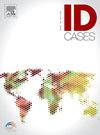Rare mycetoma caused by Raghukumaria species, a mangrove-derived dematiaceous fungus in a kidney transplant patient
IF 1
Q4 INFECTIOUS DISEASES
引用次数: 0
Abstract
We report a rare case of mycetoma after renal transplant in a patient with distant exposure to mangroves during disaster relief efforts in the Caribbean. Histopathology and fungal culture from the skin biopsy revealed findings consistent with chronic mycetoma caused by a dematiaceous mold. Next Generation Sequencing (NGS) identified the organism as closely related to Raghukumaria keshaphalae, a fungus originally isolated from mangroves. This case highlights the emerging threat posed by environmental dematiaceous fungi as obscure opportunistic pathogens in the setting of natural disasters, especially for immunocompromised patients, and the pivotal diagnostic role of NGS in invasive fungal infections.
由红树真菌引起的罕见足菌肿,一种源自红树的真菌
我们报告一个罕见的病例足菌肿肾移植后的病人与遥远的红树林暴露在救灾工作在加勒比地区。组织病理学和真菌培养从皮肤活检结果显示一致的慢性足菌肿引起的一种真菌霉菌。下一代测序(NGS)鉴定出该生物与最初从红树林中分离出来的真菌Raghukumaria keshaphalae密切相关。该病例突出了环境真菌作为自然灾害背景下,特别是免疫功能低下患者的隐性机会性病原体所构成的新威胁,以及NGS在侵袭性真菌感染中的关键诊断作用。
本文章由计算机程序翻译,如有差异,请以英文原文为准。
求助全文
约1分钟内获得全文
求助全文

 求助内容:
求助内容: 应助结果提醒方式:
应助结果提醒方式:


